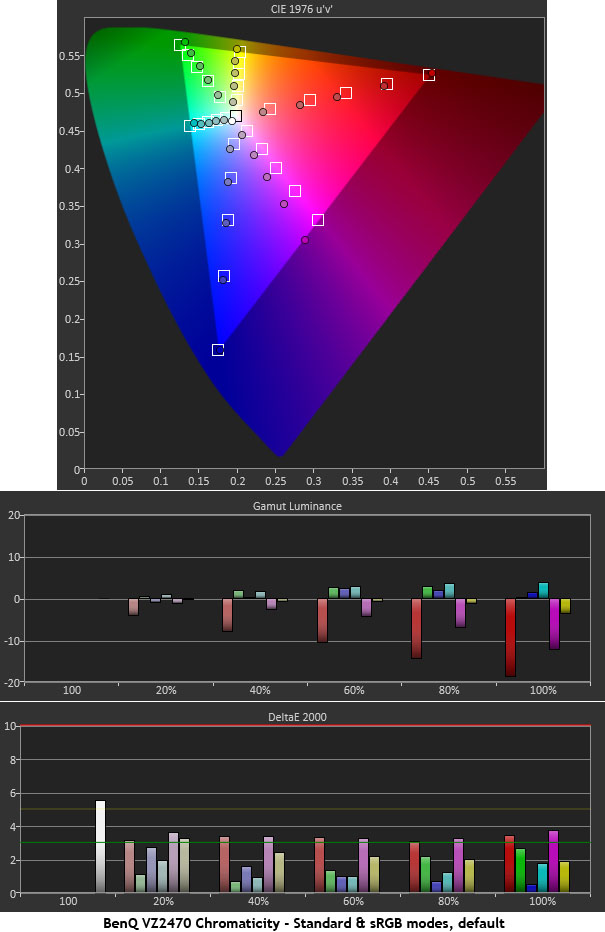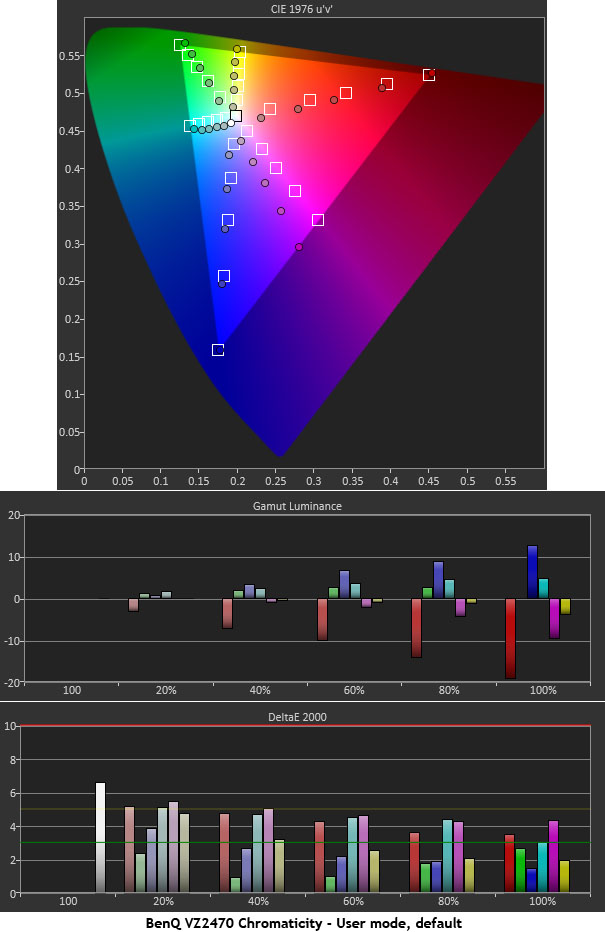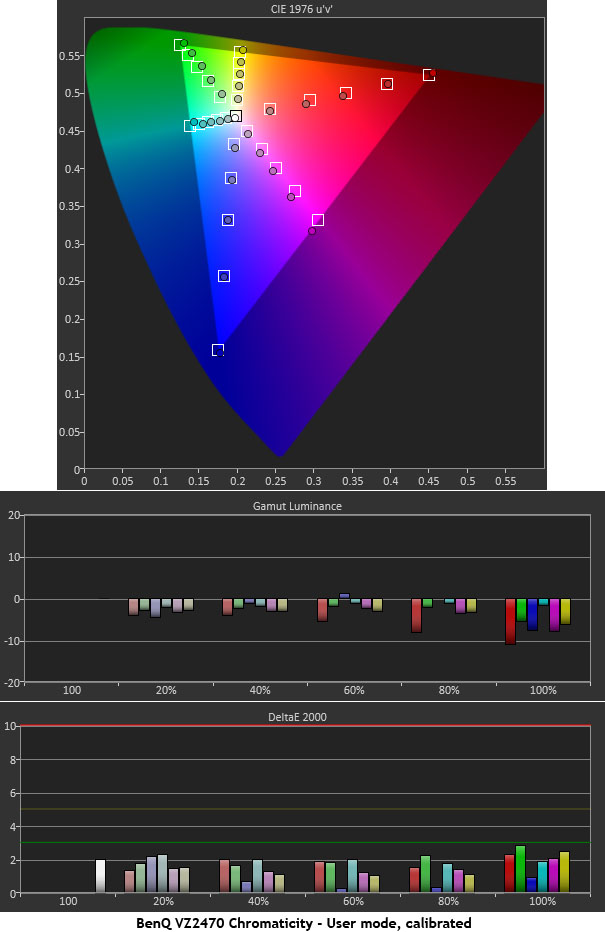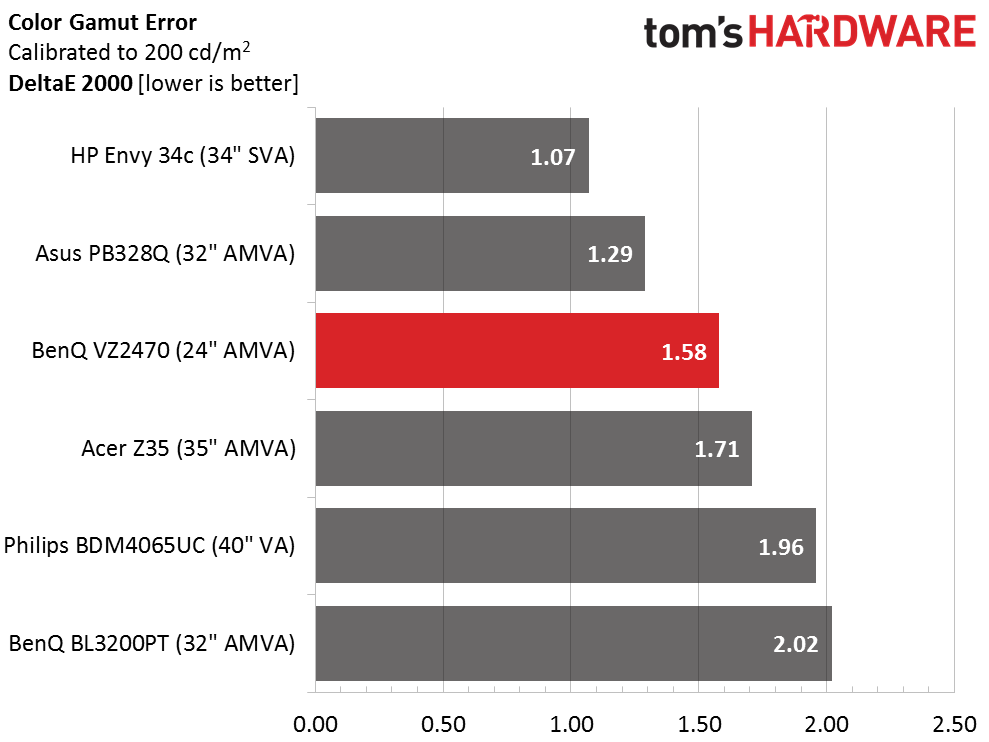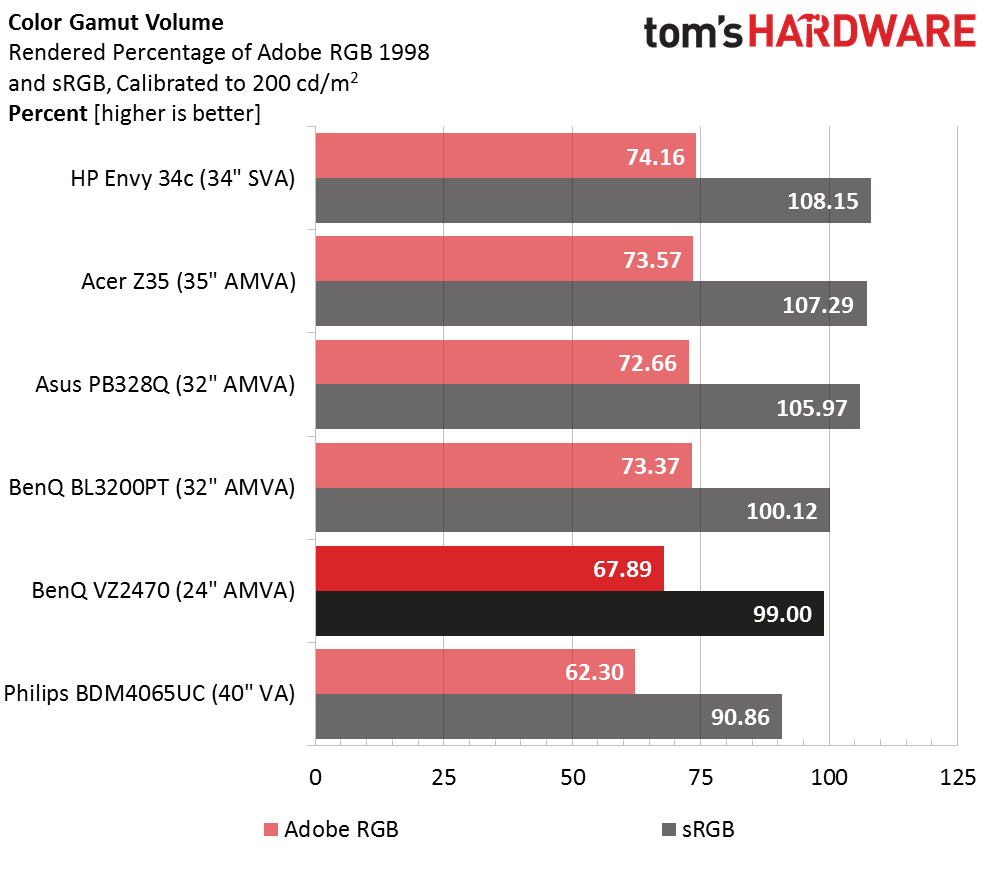BenQ VZ2470H 24-inch AMVA Monitor Review
Why you can trust Tom's Hardware
Color Gamut And Performance
For details on our color gamut testing and volume calculations, please click here.
The Standard and sRGB modes are identical in their color measurements. The fully-saturated points are right on target but there are a few errors at lower levels of red. Furthermore, the too-blue white balance pulls the magenta secondary off-hue. Red luminance should be bumped up a bit to compensate but it's actually too low, which washes out that color slightly. Overall performance is solid but there is room for improvement.
User mode shows the same tendencies to a slightly greater degree. Errors are now just over the threshold of visibility. We recommend avoiding this preset unless you plan to calibrate. You can tweak the hue and saturation controls but they affect all colors at once so if you dial in one, you may throw others off the mark.
After tweaking the RGB sliders, color is now vastly improved. The only remaining issue is a slight hue error in magenta but saturation points and luminance levels are within sight of perfection. The VZ2470H's gamut results are equal to many expensive professional displays we've tested.
Now we return to the comparison group.
It's safe to say that AMVA is a color-accurate technology. We're seeing close results among our six examples that are more consistent than what's been recorded by many IPS and TN monitors. Apparently contrast isn't the only thing it does well.
Gamut Volume: Adobe RGB 1998 And sRGB
None of the displays here are specifically designed for professional use but they all meet the sRGB gamut volume except for the Philips. The VZ2470H hits the target almost exactly and in our opinion can be used for color-critical work without a software LUT. An OSD calibration can bring it to a sufficiently accurate level.
Get Tom's Hardware's best news and in-depth reviews, straight to your inbox.
Current page: Color Gamut And Performance
Prev Page Grayscale Tracking And Gamma Response Next Page Viewing Angles, Uniformity, Response, And Lag
Christian Eberle is a Contributing Editor for Tom's Hardware US. He's a veteran reviewer of A/V equipment, specializing in monitors. Christian began his obsession with tech when he built his first PC in 1991, a 286 running DOS 3.0 at a blazing 12MHz. In 2006, he undertook training from the Imaging Science Foundation in video calibration and testing and thus started a passion for precise imaging that persists to this day. He is also a professional musician with a degree from the New England Conservatory as a classical bassoonist which he used to good effect as a performer with the West Point Army Band from 1987 to 2013. He enjoys watching movies and listening to high-end audio in his custom-built home theater and can be seen riding trails near his home on a race-ready ICE VTX recumbent trike. Christian enjoys the endless summer in Florida where he lives with his wife and Chihuahua and plays with orchestras around the state.
-
perishedinflames What's the difference between this and GW2470H? Is it just the design or is it more than that?Reply -
none12345 Only 60hz, no dvi?, no displayport? Wouldnt even consider it.Reply
Not to mention the ugly white, or the off center stand, that will make it more wobbly. And no vesa mount if you want to use your own stand.
Just EWW all around. And its not even budget at 209, way to high for 60hz. -
Nintendork It's a real shame that manufacturers forgot about 120-200Hz on 1080p 21-25° panels. Gaming monitores doesn't need to be 27" 1440p to actually get those benefits.Reply -
Nintendork For now im getting a 21° Dell Trinitron CRT.Reply
1600x1200 85Hz master race with 0ms response times. 0ms input lag :) -
Max_x2 ReplyWhat's the difference between this and GW2470H? Is it just the design or is it more than that?
My bet is that the only difference is the design. If you're in the market for a great, cheap all-around monitor, I'd say buy the GW2470H. Had my GW2450 for about 3 years, and I'm still in love with it. The color accuracy is unmatched except maybe for monitors worth 4-5 times the price, and I also enjoy it for some casual gaming (racing simulators mostly in my case).
Here's a review of mine: http://www.tftcentral.co.uk/reviews/content/benq_gw2450hm.htm . Anyway, what I can tell you is that this was my 1st BenQ monitor, but sure won't be the last. The quality is amazing. -
basroil Looks like another ( Mod edit: Keep it clean....)benq monitor that looks fine on paper but will be troubled with quickly degrading screens and wonky controls that were outdated a decade agoReply
*edit* anort3, I used no words that would not be acceptable in a PG rating. It was certainly far cleaner than some comments by others including mods! -
Max_x2 You do know that they own auoptronic, which supplies panels for a lot of displays, right? Also, their parts are in a lot of other companies monitors, beside the actual panel.Reply -
ozicom I've been trying to upgrade my display to 4K and i'm sure most people will try to do this while 4K is not a dream anymore. Apple and Dell and i think some other manufacturers start to produce 5K and more and now we're looking at a FHD monitor. I know mainstream means low price but buying a FHD monitor with no added options looks dummy. So let's try to push brands and manufacturers to make better for less.Reply -
atwspoon ReplyIt would be nice if you note that this is sponsored article.
How does one note that fact?
